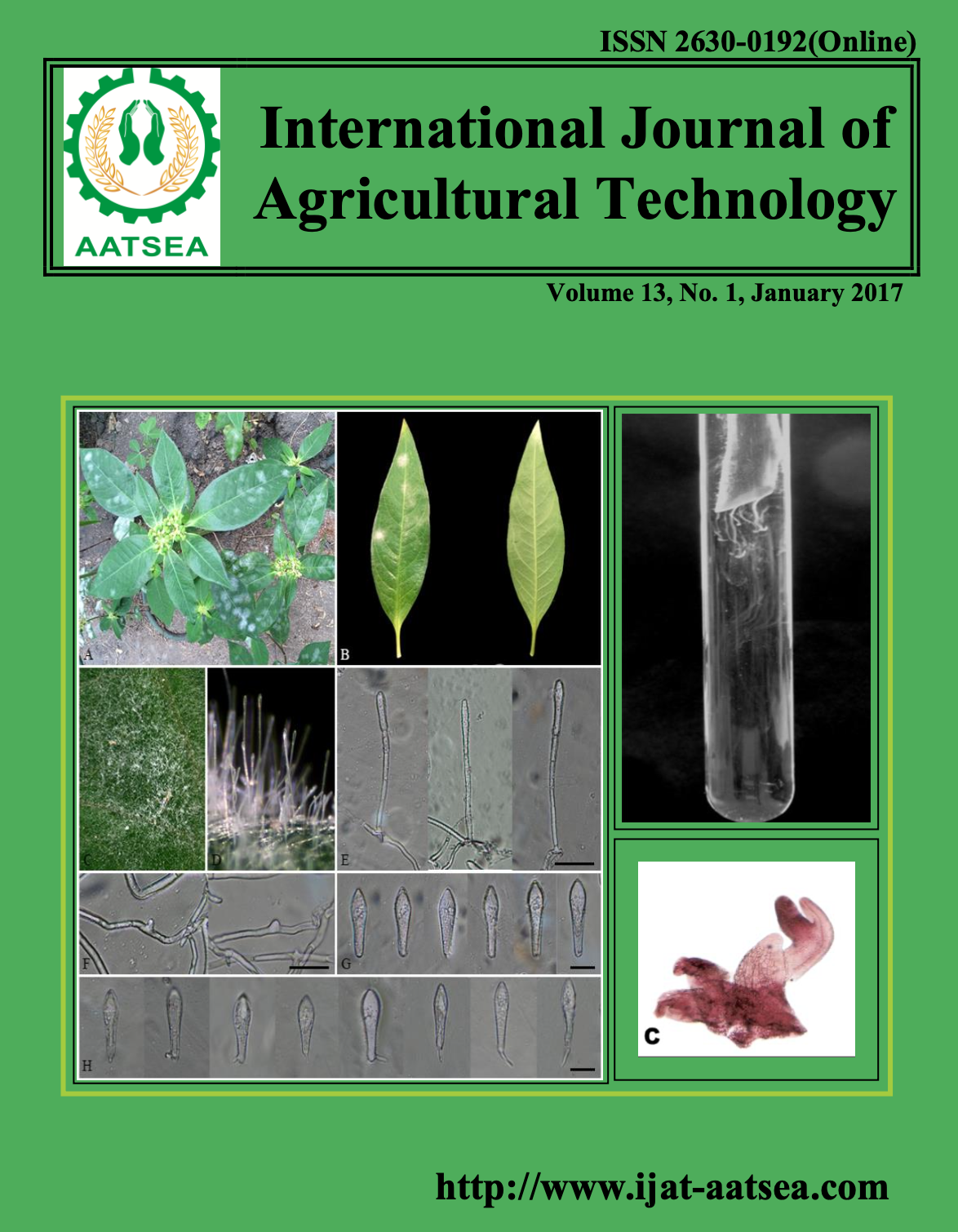Effects of arachidonic acid supplementation in maternal diet on low-salinity tolerance of newly hatched larvae of giant freshwater prawn (Macrobrachium rosenbergii De Man)
Main Article Content
Abstract
Arachidonic acid (20:4n-6, ARA) is an important fatty acid in giant river prawn reproduction. Improving larval quality may be possible through improved nutrition of maternal diets. The present study evaluated the effects of ARA supplementation in maternal diets on survival rates of newly hatched larvae exposed to six salinity levels (0, 2, 4, 6, 8, and 14 ppt) for 24 hours. Six experimental diet consisted of two base diets differing in fish oil (FO)/soy oil (SO) blends (A and B) and three ARA supplementation levels 0, 0.4 and 0.8%. The two diets diffred in the proportional contents of linoleic acid (18:2n-6, LOA, B>A) and docosahexaenoic acid (22:6n-3, DHA, A>B). At 2, 4 and 6 ppt, the survival rates at 24 hours of newly hatched larvae from females fed the diet with 0.8% ARA supplementation and higher LOA contents from SO (diet B2) were highest followed by those fed the B1 diet (0.4% supplemented ARA) (p<0.05) (B2=87.04, 93.32 and 98.88%; B1=79.23, 91.84 and 97.03 % for 2, 4 and 6 ppt respectively). Similarly, 24-hour LD50 values were lowest for the B2 treatment (0.80±0.02), suggesting their high tolerance to extremely low salinity levels. Our results have a great implication for an inland hatchery operation where seawater is a scarce resource.
Article Details

This work is licensed under a Creative Commons Attribution-NonCommercial-NoDerivatives 4.0 International License.
References
Analystsoft. (2008). StatPlus. Mindspark Ineractive Network, Inc. http://www.analystsoft.com
Bell (1985). Effects of dietary polyunsaturated fatty acid deficiencies on mortality, growth and gill structure in the turbot, Scophthalmus maximus. Journal of fish biology 26:181-191.
Cavalli, R., Lavens, P., and Sorgeloos, P. (1999). Performance of Macrobrachium rosenbergii broodstock fed diets with different fatty acid composition. Aquaculture 179: 387-402.
Cavalli (2001). Variations in lipid classes and fatty acid content in tissues of wild Macrobrachium rosenbergii de Man females during maturation. Aquaculture 193:311-324.
Chand (2015). Effect of salinity on survival and growth of giant freshwater prawnMacrobrachium rosenbergii (de Man). Aquaculture Reports 2:26-33.
D’Abramo, L. R. and Sheen, S. S. (1993). Polyunsaturated fatty acid nutrition in juvenilefreshwater prawn Macrobrachium rosenbergii. Aquaculture 115:63-86.
De Caluwe, J., Lavens, P. and Sorgeloos, P. (1995). The influence of Macrobrachiumrosenbergii broodstock diet on egg and larval characteristics. In P. Lavens, E. Jaspers, and I. Roelants (Eds.), Larvi ’95. Shellfish Larviculture Symposium. European Aquaculture Society, Gent: Belgium 24:79-82.
Department of Fisheries. (2007). Fishery Statistics of Thailand 2005. Document No. 6/2007 Fisheries Information Technology Center, Department of Fisheries, Ministry of Agriculture and Cooperatives, Bangkok, Thailand. 91 pp.
Food and Agriculture Organization (FAO). (2013). Fisheries and Aquaculture Department, Statistics and Information 957 Service FishStatJ: Universal software for fishery statistical time series. Copyright 958 2011.Version 2.1.0.
Food and Agriculture Organization (FAO). (2016). FAO Yearbook Fishery and Aquaculture Statistics 2014. Rome, Italy.
Grasshoff, K. (1976) Methods of Seawater Analysis. Weinheim.Verlag Chemie. 317 pp.
Glencross, B. E. (2009) Exploring the nutritional demand for essential fatty acids by 595 aquaculture species -A review. Aquaculture Reviews, submitted.
Habashy (2012). Morphological and histological studies on the embryonic development of the freshwater prawn, Macrobrachium rosenbergii (Crustacea, Decapoda). The Journal of Basic & Applied Zoology 65:157-165.
Kangpanich (2016). Effects of arachidonic acid supplementation in maturation diet on female reproductive performance and larval quality of giant river prawn (Macrobrachium rosenbergii). Peer Journal 4:e2735.
Kassambara, A. (2015). Factoextra: extract and visualize the results of multivariate data analyses. R package version 1.0.3. Retrieved from http://www.sthda.com.
Kumar (2013). Effect of dietary supplementation of Bacillus licheniformis on gut microbiota, growth and immune response in giant freshwater prawn, Macrobrachium rosenbergii (de Man, 1879). Aquaculture International 21:387-403.
Lê, S., Josse, J. and Husson, F. (2008). FactoMineR: an R package for multivariateanalysis. Journal of Statistical Software 25:1-18
Lytle, J. S., Lytle, T. F., and Ogle, J. T. (1990). Polyunsaturated fatty acid profiles as a comparative tool in assessing maturation diets of Penaeus vannamei. Aquaculture 89:287-299.
Nandlal, S. and Pickering, T. (2005). Freshwater prawn Macrobrachium rosenbergii farming in Pacific Island countries (Hatchery operation (Volume: 1). Noumea, New Caledonia, Secretariat of the Pacific Community.
New, M. B. (2003). Farming freshwater prawns: A manual for the culture of the giant river prawn (Macrobrachium rosenbergii). FAO Fisheries Technical Paper, Vol. 428. A network of aquaculture Centers in Asia Pacific, Rome, Italy, pp. 11-27.
New, M. B. (2005). Freshwater prawn farming: global status, recent research and a glance at the future. Aquaculture research 36:210-230.
Palacios (2004). Influence of highly unsaturated fatty acids on the responses of white shrimp (Litopenaeus vannamei) postlarvae to low salinity. Journal of Experimental Marine Biology and Ecology 299:201-215.
R Core Team. (2015). R: a language and environment for statistical computing. Vienna: R Foundation for Statistical Computing.
Singh. T. (1980). The iso osmotic concept in relation to the aquaculture of the giant prawn, Macrobrachium rosenbergii. Aquaculture 20:251-256.
Somsueb, P. (2009). Department of Fisheries, Bangkok (Thailand). Inland Fisheries Research and Development Bureau. Inland Feed Research Institute.
Sumpownon (2015). Variation of prostaglandin E2 concentrations in ovaries and its effects on ovarian maturation and oocyte proliferation in the giant fresh water prawn, Macrobrachium rosenbergii. General and Comparative Endocrinology 223:129-138.
Van, A. (2012). The effects of arachidonic acid on the endocrine and osmoregulatory response of tilapia (Oreochromis mossambicus) acclimated to seawater and subjected to confinement stress. Fish Physiology and Biochemistry 38:703-713.


